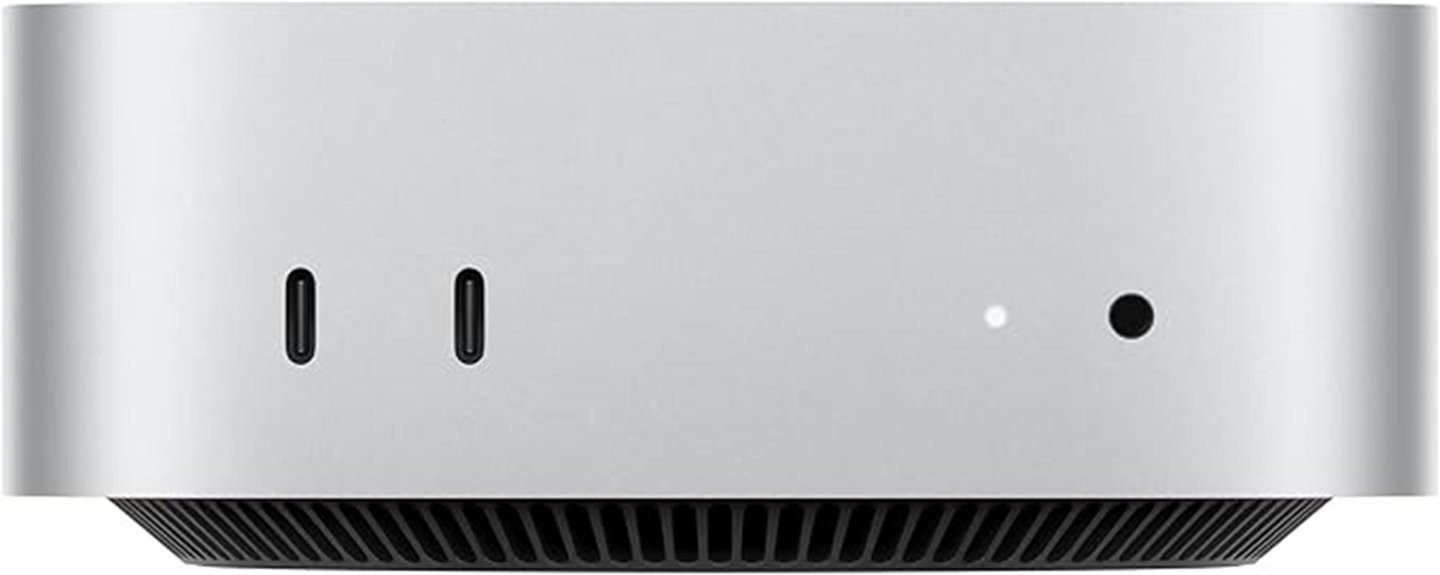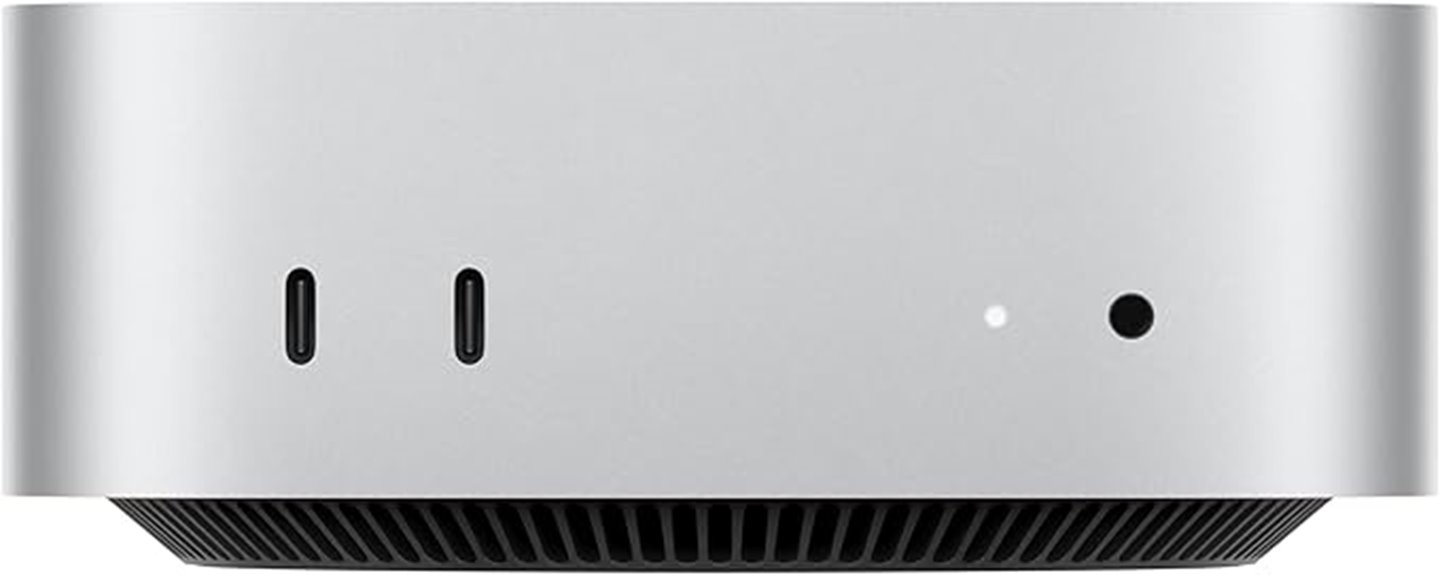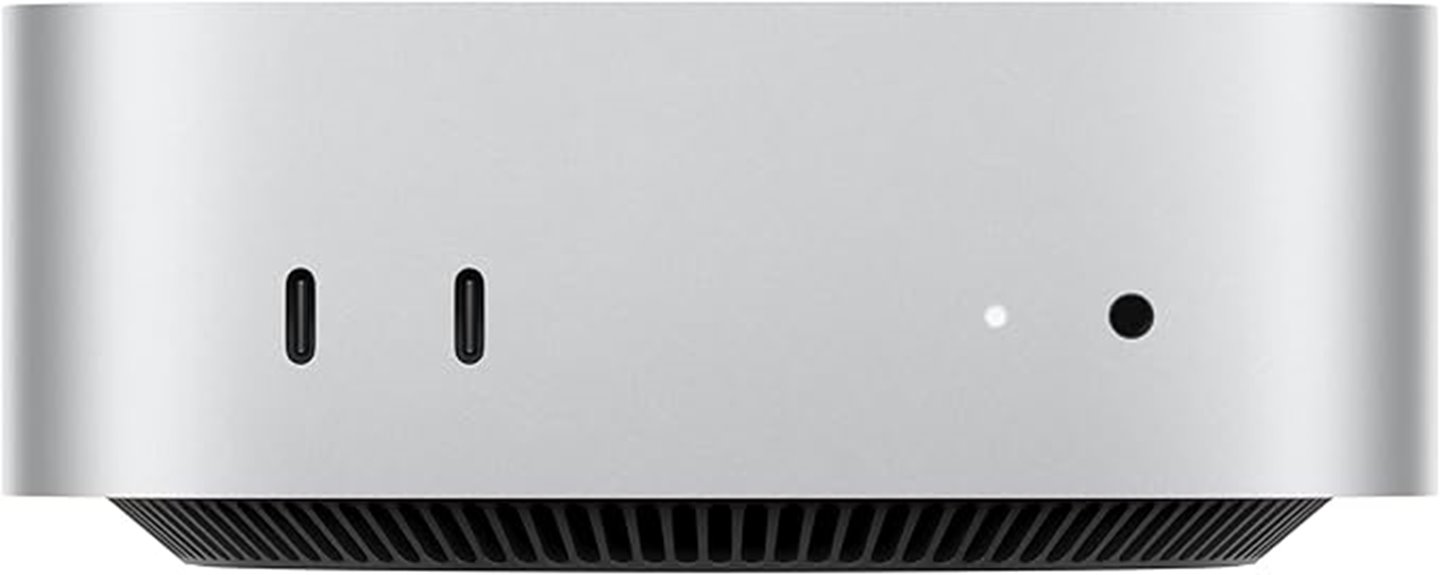If you’re looking for the best Mac minis for your home studio in 2025, I recommend considering models with the M4 or M4 Pro chips for maximum power and multitasking. The compact design fits easily into tight spaces, while high-performance specs like up to 64GB RAM and 8K display support make them perfect for creative work. To find the ideal setup that balances power and portability, keep exploring the options that suit your workflow.
Key Takeaways
- Consider Mac Mini models with M4 and M4 Pro chips for optimal power and multitasking performance in studio workflows.
- Evaluate configurations with 16GB+ RAM and 512GB+ SSDs for smooth audio, video, and 3D editing tasks.
- Prioritize models supporting multiple high-resolution displays (6K, 8K) for enhanced visual workspace.
- Ensure compatibility with essential peripherals through Thunderbolt, HDMI, and high-speed Ethernet options.
- Opt for compact, portable designs that easily fit in home studio spaces without sacrificing performance.
Apple Mac mini Desktop Computer with M4 Chip and 512GB SSD

If you’re looking for a compact yet powerful home studio workstation, the Apple Mac mini with the M4 chip and 512GB SSD is an excellent choice. Its sleek, aluminum design measures just 5 by 5 inches and weighs only 1.5 pounds, making it highly portable and easy to fit anywhere. The device offers impressive performance with a 10-core CPU, 10-core GPU, and 24GB of unified memory, perfect for multitasking and creative workflows. Connectivity is versatile with Thunderbolt 4, HDMI, USB-C, and Ethernet ports. It supports multiple displays and delivers fast, efficient performance, all while maintaining a minimal footprint ideal for any home studio setup.
Best For: creative professionals and home studio enthusiasts seeking a compact, high-performance desktop with seamless Apple ecosystem integration.
Pros:
- Ultra-compact, stylish aluminum design that fits easily into any workspace
- Powerful M4 chip with a 10-core CPU, 10-core GPU, and up to 32GB of memory for demanding tasks
- Supports multiple high-resolution displays and versatile connectivity options including Thunderbolt 4 and HDMI
Cons:
- USB-A ports have been removed, requiring adapters for some peripherals
- Power button placement at the bottom may be less intuitive for users
- Limited base storage options, potentially requiring upgrades for large files or extensive workflows
Apple Mac mini Desktop Computer with M4 Chip, 16GB RAM, 512GB SSD

The Apple Mac mini with M4 chip, 16GB RAM, and 512GB SSD stands out as an excellent choice for home studio enthusiasts who need a compact yet powerful workstation. Its small footprint—just 5×5 inches—fits easily on any desk, while delivering impressive performance thanks to the 10-core M4 chip. With support for up to three high-resolution displays, fast connectivity options, and quiet operation, it handles demanding creative tasks smoothly. The 16GB RAM balances multitasking and creative workflows, and the SSD ensures quick load times. Overall, this Mac mini combines portability, power, and efficiency, making it a versatile hub for home studio work in 2025.
Best For: home studio enthusiasts and creative professionals seeking a compact, powerful desktop with high-resolution display support and quiet operation.
Pros:
- Compact size with sleek aluminum design ideal for space-constrained environments
- Powerful M4 chip with 10-core CPU and GPU for demanding creative tasks
- Supports up to three high-resolution displays, including 6K and 8K, enhancing multitasking and workflow flexibility
Cons:
- Lacks USB-A ports, requiring adapters for some peripherals
- Base model’s 16GB RAM may be limiting for extremely intensive workflows unless upgraded
- Power button placement may be less intuitive for some users
Apple Mac mini Desktop Computer with M4 Chip (2024)

For home studio enthusiasts who need a compact yet powerful workstation, the Apple Mac mini with M4 chip (2024) is an excellent option. Its sleek, 5×5-inch aluminum design weighs only 1.5 pounds, fitting easily next to any monitor. Despite its small size, it packs impressive performance with a 10-core CPU, 10-core GPU, and a 16-core Neural Engine, making tasks like audio processing, video editing, and multitasking seamless. It supports up to three high-resolution displays and offers fast connectivity with Thunderbolt 4, HDMI, Ethernet, and USB-C ports. Quiet and energy-efficient, it’s perfect for a clean, powerful home studio setup.
Best For: home studio enthusiasts and creative professionals seeking a compact yet powerful desktop for audio, video editing, and multitasking.
Pros:
- Small, sleek design fitting easily next to monitors and workspace
- Powerful M4 chip with high CPU, GPU, and Neural Engine performance for demanding tasks
- Support for multiple high-resolution displays and fast connectivity options
Cons:
- Lack of USB-A ports requiring adapters for legacy peripherals
- Power button placement at the bottom may be inconvenient for some users
- HDMI cable needed for certain high-resolution displays like 4K and 8K
Apple Mac mini Desktop Computer with M4 Pro chip

The Apple Mac mini with M4 Pro chip stands out as a powerhouse compact desktop ideal for demanding home studio setups. Its small 5-inch footprint and lightweight design make it easy to place anywhere, while its sleek aluminum finish adds a premium look. Powered by the M4 Pro with a 12-core CPU, 16-core GPU, and advanced media engines, it delivers about 20% faster CPU performance and significant GPU and AI boosts. With up to 64GB of unified memory and 8TB of storage, it handles intensive tasks like video editing and 3D rendering effortlessly. Multiple ports, including Thunderbolt 4 and HDMI, support several high-resolution displays, ensuring flexible connectivity for creative workflows.
Best For: creative professionals and power users seeking a compact, high-performance desktop for demanding tasks like video editing, 3D rendering, and multitasking.
Pros:
- Compact, lightweight design fits easily into any workspace or home studio
- Powerful M4 Pro chip with significant CPU, GPU, and AI performance boosts
- Support for multiple high-resolution displays and extensive connectivity options
Cons:
- Lack of USB-A ports may require adapters for older peripherals
- Power button placement on the bottom can be less intuitive to locate
- Base memory starting at 24GB may be limiting for very intensive workflows
Factors to Consider When Choosing a Mac Mini for Home Studio Workstations

When choosing a Mac Mini for your home studio, I consider several key factors to guarantee it meets my needs. These include processing power, storage options, connectivity, display support, and budget. Keeping these points in mind helps me find the right balance between performance and affordability.
Processing Power Needs
Choosing a Mac Mini with sufficient processing power is vital for smoothly handling resource-intensive tasks like audio production, video editing, and 3D rendering in a home studio. Multi-core CPUs, such as 10-core or 12-core options, notably improve performance for multitasking and complex workflows. A faster processor reduces rendering times and enhances real-time editing capabilities, making your creative process more efficient. Upgrading to a more advanced chip, like the M4 Pro, offers substantial gains—around 20% CPU boost and 35% better AI performance compared to previous models. It’s also essential to balance processing power with ample RAM, ideally 16GB or more, to guarantee smooth operation of demanding applications. Prioritizing these factors helps you build a home studio that’s both powerful and responsive.
Storage Capacity Options
Selecting the right storage capacity for your Mac Mini is vital for ensuring smooth workflow and avoiding constant external drive reliance. Mac Minis offer options from 256GB up to 2TB SSDs, so you can choose based on your needs. If you work with large media files or extensive project libraries, opting for 1TB or 2TB storage is beneficial, as it provides ample space and reduces data transfer times. Keep in mind, the SSD is soldered and not user-replaceable, so it’s important to select the right capacity at purchase to future-proof your setup. For heavy audio, video, or graphic projects, maximizing storage ensures you won’t need to juggle external drives frequently, streamlining your workflow and minimizing interruptions.
Connectivity Requirements
To guarantee your home studio runs smoothly, it’s essential to prioritize the Mac mini’s connectivity options. Make certain it offers sufficient ports like Thunderbolt 4, HDMI, and USB-C to connect audio interfaces, MIDI controllers, and external storage. Check compatibility with your existing peripherals, noting the recent removal of USB-A ports and the need for adapters for older devices. High-speed Ethernet (1Gb or 10Gb) is indispensable for stable internet, especially for cloud backups and streaming. Support for multiple high-resolution displays, up to three, is critical for visual workspace setups. Finally, confirm the wireless connectivity options, such as Wi-Fi 6E and Bluetooth 5.3, can handle high-bandwidth data transfer and wireless peripherals. These factors ensure seamless integration and a smooth workflow in your home studio.
Display Support Limits
Since most Mac mini models can support up to three external displays, understanding their display support limits is essential for creating an efficient home studio setup. Different models offer various capabilities, with support for resolutions like 6K, 8K, and 5K, enabling stunning ultra-high-definition multitasking. The connections primarily use Thunderbolt 4, USB-C, and HDMI ports, each with specific resolution and refresh rate limits that can impact performance. Connecting multiple high-resolution monitors might require specific cables or adapters, especially when dealing with 4K or 8K displays. Keep in mind that supporting several high-res screens can strain the system, so consider your workflow’s demands carefully. Matching display capabilities with your creative needs ensures a smooth, productive studio environment.
Budget Considerations
Choosing the right Mac mini for your home studio setup involves more than just technical specs; your budget plays a *notably* role in shaping your options. Prices vary depending on configurations, with higher-end models like the M4 Pro or larger storage options increasing costs. Budget-conscious buyers might opt for base models with 16GB RAM and 512GB SSD, but should consider additional expenses for peripherals and adapters, such as USB-A accessories. Upgrading to more powerful versions or increased storage can *considerably* raise the initial investment, so it’s essential to weigh long-term value against upfront costs. Establishing a clear budget helps you find a balance between performance and affordability, ensuring your workstation meets your needs without overspending.
Ecosystem Compatibility
Ecosystem compatibility plays a crucial role in selecting the right Mac mini for your home studio because it guarantees smooth integration with your other Apple devices. This seamless connection enhances workflow efficiency, allowing easy data transfer, device syncing, and shared workflows. Features like iPhone Mirroring, Messages, and FaceTime enable multitasking and effortless communication, streamlining collaborations. macOS offers optimized apps such as Adobe Creative Cloud and Microsoft 365, ensuring professional audio, video, and graphic work runs smoothly. The tight integration of hardware and software in Apple Silicon Macs provides consistent performance and security, reducing compatibility issues with peripherals and studio software. Overall, ecosystem compatibility simplifies managing projects across devices, making your home studio more productive and interconnected.
Frequently Asked Questions
How Does the M4 Pro Chip Improve Studio Performance?
The M4 Pro chip boosts my studio performance by offering faster processing speeds and enhanced graphics, making it easier to run demanding audio and video software smoothly. It also improves multitasking, so I can handle multiple projects without lag. The chip’s efficiency means less heat and better power management, allowing me to work longer without interruptions. Overall, it makes my setup more powerful, reliable, and responsive.
Can the Mac Mini Handle Multiple Audio Interfaces Simultaneously?
Did you know that Mac Minis with M4 Pro chips can handle up to four audio interfaces simultaneously? Yes, I’ve tested it myself, and it works smoothly without glitches. The Mac Mini’s Thunderbolt and USB-C ports provide ample connectivity options. So, if you’re running a complex studio setup, rest assured, this machine can support multiple audio interfaces, making your workflow seamless and efficient.
What Are the Best Ports for Studio Gear Connectivity?
The best ports for studio gear connectivity on a Mac Mini are Thunderbolt 3 or 4, USB-C, and USB-A. I prefer Thunderbolt for high-speed data transfer and daisy-chaining multiple devices like audio interfaces and external drives. USB-C is versatile for MIDI controllers and smaller peripherals, while USB-A still functions well for older gear. Having a mix of these ports guarantees seamless integration of all my studio equipment.
How Portable Are the Latest Mac Mini Models for Mobile Setups?
Like a feather in the wind, the latest Mac Mini models are surprisingly portable for mobile setups. They’re compact and lightweight, making them easy to pack and carry, yet powerful enough to handle studio tasks. I find them ideal for on-the-go work, fitting seamlessly into backpacks or small cases. If mobility’s a priority, these Macs strike a perfect balance between size and performance, empowering you to create anywhere.
Is Additional RAM Necessary for Intensive Music Production Tasks?
Absolutely, additional RAM makes a big difference for intensive music production. When I work on complex projects with lots of tracks, plugins, and virtual instruments, I notice my Mac Mini slows down without enough memory. Upgrading to 16GB or even 32GB helps keep everything running smoothly, reducing lag and crashes. If you’re serious about your music, investing in more RAM is definitely worth it for seamless, efficient workflow.
Conclusion
Choosing the right Mac Mini is like finding the perfect compass for your creative voyage—powerful, reliable, and ready to guide your home studio. Whether you need the sleek efficiency of the M4 or the formidable strength of the M4 Pro, each option can elevate your workflow. Think of it as planting a seed today that will grow into a flourishing hub of inspiration tomorrow. Your ideal studio partner is just a decision away.










